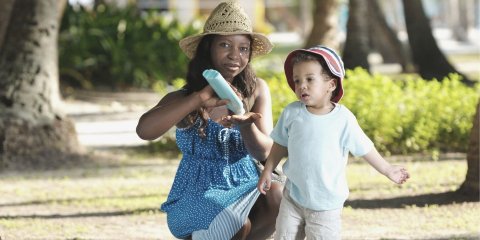Key Points
- Damage from UV rays is cumulative, so it’s important to start with good sun protective measures early
- Sunscreen is one such protective measure, but should never be used as the sole measure
- Sunscreens for toddlers tend to contain gentler ingredients than regular sunscreens
- A liberal application of sunscreen is needed to ensure the level of sun protection reaches that specified on the product
- Patch testing is a good way to test sunscreens on toddlers
Safe sun practices are a must - no matter how old you are. In fact, sun exposure during childhood is one of the risk factors for developing skin cancer later in life.
Specifically, it’s the UV radiation in sunlight that causes the majority of skin cancers. Scarily, by 70 years of age, two out of three Australians will have been diagnosed with skin cancer.
This brings us to the question of how you can best protect your toddler now, so they don’t become one of those terrifying statistics?

We’ll cover all sun safe practices briefly in this article, but specifically, we want to focus on the use of sunscreen for toddlers. Because, let’s face it, there’s a lot of choice out there when it comes to buying sunscreen.
Do you choose roll-on or pump bottles, one brand over another, and is there really any difference between “kids” sunscreen and regular sunscreen anyway?
Risks from sun exposure to toddlers
Up to the age of two, and perhaps later, skin is much more sensitive to ultraviolet radiation. The outermost layer of the skin (the stratum corneum) is thinner , and levels of protective melanin, which is responsible for blocking UV radiation , are lower.
It is now clearly established that infants' skin is particularly sensitive to ultraviolet (UV) radiation and remains vulnerable as it gains maturity, up to at least the age of 2 years
That means if your toddler’s skin isn’t well-protected, they are at a higher risk of experiencing damage than adults. And because damage is cumulative, they are on the backfoot right from the start when it comes to developing skin cancer later in life.
If you think about it, they are not just physiologically at greater risk of damage by sun exposure, but also from a behavioural perspective. That’s because toddlers are incapable of implementing their own sunsmart measures . As their parent, you are completely responsible for this, so the quality of their sun protection depends on how you approach it.
Of course, it’s not only important that you implement sun protection measures for them, but also for yourself. Modeling the appropriate behaviour lays the foundation for them to follow on with, and hopefully understand the importance of sun safety throughout their life.
Sun safety measures for toddlers
Let’s touch on all sun safe practices you should use with your toddler now, before we look specifically at sunscreen for toddlers.

The Cancer Council recommends that a combination of sun protective practices are used when the level of UV measures three or above. The Bureau of Meteorology has a UV and sun protection guide you can consult to find out the UV levels for your location. Alternatively, you can also check the SunSmart app .
The Cancer Council’s five recommended sun safety practices include:
- Slip on some sun-protective clothing that covers as much skin as possible. Look for a UV protection factor of at least UVP15. If clothing doesn’t have a UVP rating, then those made of closely woven fibres are best - preferably heavyweight natural fibres, such as linen and cotton.
- Slop on a broad spectrum, water resistant SPF30 (or higher) sunscreen.
- Slap on a hat – broad brim or legionnaire style are best in order to protect their face, head, neck and ears. Caps are unsuitable as they provide far less protection.
- Seek shade. It’s important to remember that UV rays can still reach the skin when in the shade , because they reflect off surfaces like concrete and sand. That’s why shade can’t be used as a standalone sun protective measure.
- Slide on some sunglasses – make sure they meet Australian Standards because toy or fashion sunglasses don’t provide the same benefits. If it’s not practical for your toddler to wear sunglasses, this is a good place to reiterate the importance of the right hat. That’s because “ wearing a hat with a brim can reduce UV radiation to the eyes by 50% ”.
Now, let’s get down to the specifics of choosing and using sunscreen for toddlers.
Safe sunscreens for your toddler?
You’ve no doubt seen them on supermarket shelves, and you’ve probably already bought “baby sunscreen” or “kids sunscreen” believing it is best suited to your child’s skin. But, is it really?
Sunscreens designed for babies and kids aren’t a whole lot different than those for adults. Often, they are fragrance-free, because fragrances can be a common cause of irritation to the skin, and babies and young toddlers do often have more sensitive skin.
These sunscreens may also use alternative active ingredients that are gentler on the skin than those in general sunscreens. To demonstrate this point, Canstarblue.com.au ran a comparison on the ingredients in two Hamilton Sun sunscreens :
“Hamilton Active Family
- Octyl salicylate 5% (UVB blocker)
- Homosalate 10% (UVB blocker)
- Butyl methoxydibenzoylmethane 4% (UVA blocker; aka avobenzone)
- Octocrylene 8% (UVB blocker)
Hamilton Baby & Toddler
- 4-Methylbenzylidene camphor 4% (UVA blocker)
- Ethylhexyl triazone 3% (UVB blocker)
- Butyl methoxydibenzoylmethane 4% (UVA blocker; aka avobenzone)
- Octocrylene 4% (UVB blocker)”
You can see that a few of the ingredients are different, and one of the common ingredients is used in a lower concentration in the baby and toddler version.
Importantly, both still block UVA and UVB rays for an SPF rating of 50.
This is not to say that you can’t use adult sunscreen on your toddler, but they may be more likely to have some skin irritation or a larger reaction to it.
A good way to find out if a sunscreen is suitable for your toddler is to do a patch test first, where you apply only a small amount to a small area of skin. As facial skin is more sensitive, this is a good place to test it.
But, what about how the sunscreen is packaged, is one type of bottle better for application than another?
Many kids sunscreens now come in roll-on or spray bottles. This is because application can be easier in these forms.
However, to get that really liberal application we’ve been talking about, sunscreen in a pump bottle is usually best (although potentially more messy). The Cancer Council found that when people used aerosol sprays particularly, they did not use nearly enough .
How much sunscreen to put on toddlers?
When it comes to sunscreen application, this is possibly the most important point: when you do not apply a thick enough layer, the sunscreen can not protect your toddler to the full extent of the product's SPF rating.
How much sunscreen to put on toddlers? Toddlers often do not have enough sunscreen on them providing ineffective protection from UV and resulting in a quicker time to burn than expected. Based on the adult recommendations from the cancer council, a Toddler should have at least 1/2 a teaspoon per limb (3 and 1/2 teaspoons total) but could be more depending on toddler size.
“ Most people don’t apply enough sunscreen resulting in only 50-80% of the protection stated on the product.” So even if you apply an excellent SPF50+ sunscreen on your toddler, if you do not apply enough, they will not be protected from UV exposure to the extent you expect them to be.
So, how much is enough?
You might be shocked to hear just how liberally sunscreen should be applied. In fact, the Cancer Council recommends “ at least a teaspoon for each limb, front and back of the body, and one teaspoon for the face, neck and ears ” (around seven teaspoons total).
Please note that this is intended as a guide for applying sunscreen to an adult . As toddlers are obviously smaller, they may need less. Try testing these quantities when you apply your own sunscreen so you have a good idea of the thickness of coverage required.
Remember: sunscreen does not completely block all UV radiation, and is therefore not recommended to be used as the sole method of sun protection.
When and how frequently to apply sunscreen on your toddler
We’ve all made the mistake of waiting until we’re at the park or the beach before applying sunscreen on our toddler. Unfortunately, for sunscreen to effectively block as much UV radiation as possible, it should be applied 20 minutes before sun exposure. This gives it time to adequately bind to the skin .

When you check the labelling on your sunscreen you might notice it says to reapply every two hours or it might say to reapply every four hours. This is important: no matter what it says, you should always reapply it to your toddler every two hours.
Testing happens in laboratories, not real-world conditions, so the Cancer Council recommends erring on the side of caution and always reapplying every two hours .
But there are other instances when you should be reapplying too:
- When they have been swimming
- When they have been towel-dried
- When they have been sweating
All of these circumstances can reduce the effectiveness of the sunscreen because some of it will have rubbed off.
4 must-haves to look for in your toddlers sunscreens
Ultimately, when you’re choosing a sunscreen for your toddler, you should check the packaging for these four must-haves:
- SPF 50 , which currently offers the highest level of protection from UV rays
- Broad spectrum , which filters both UVA and UVB rays
- Water resistant formula , although not completely waterproof, it will still be more beneficial than those that are not water resistant
- Approved by a responsible body like the Australian Government's Therapeutic Goods Administration, which regulates sunscreens for sale in Australia
Although your toddler might take some persuading to let you apply sunscreen to their skin, it’s well worth the effort - for now, but also to reduce their risk of skin cancer later in life.

